
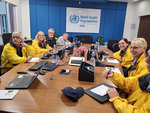
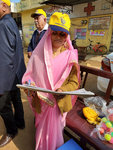
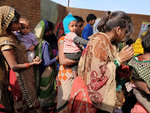
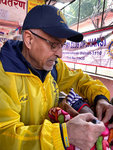

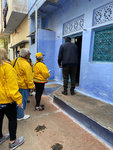

In the United States, polio is a long-distant memory — perhaps passed down through family stories, perhaps forgotten.
But in other parts of the world, the paralyzing and sometimes deadly disease is a persistent threat for unvaccinated children — particularly babies and toddlers.
In an effort to eradicate the disease, volunteers from Rotary clubs, including Centralia’s Anil Puri of Twin Cities Rotary, flew to the other side of the world earlier this month to join an effort to vaccinate children throughout the country for National Immunization Day.
For Puri, the trip had special significance.
“To me it was a pilgrimage, going back to the country of my birth,” he said.
Rotary International has long helped fund polio immunization, and Puri has raised money locally toward the effort, while watching other Centralia and Chehalis residents make the trip to India to help vaccinate children.
Earlier this month, he made the trip for himself for the first time, traveling to the city of Jhansi in the southwest corner of India, where 300,000 children needed to be vaccinated over a two-day period.
The scope of the effort, while in the middle of it, was staggering, he said.
“Moist eyes. You can’t help it,” he said.
India vaccinates 170 million children each year in an effort to eradicate polio, deploying 2.3 million volunteers on twice yearly events called National Immunization Day — which are actually five-day events geared toward stopping the disease.
“My mission was twofold, one was to be there and actually give the drops,” he said. “And the second thing, I wanted to study, as an engineer, how did it happen, how was India able to do it.”
India hasn’t had a new polio case since 2011, Puri said.
Puri, assistant governor of Rotary’s Area 16 and past president of the Twin Cities Rotary Club, and the other volunteers went to India earlier this month as part of a larger effort by the Global Polio Eradication Initiative, a public-private partnership between governments, the World Health Organization, Rotary International, the U.S. Centers for Disease Control and Prevention, the United Nations Children’s Fund (UNICEF), the Bill and Melinda Gates Foundation and Gavi, the Vaccine Alliance. GPEI was founded in 1988 and since then has vaccinated 2.5 billion children in 200 countries.
Polio, or Poliomyelitis, is a potentially deadly disease that mainly affects young children — mostly those under 5 years old, according to the WHO. The virus attacks the nervous system, and can cause total paralysis in hours. Among victims who experience paralysis, between 5 and 10 percent die, according to the WHO.
While Polio used to be a deadly disease throughout the world, it has been eradicated in the United States.
Globally, type 2 and 3 polio have been eradicated, but type 1 is still a threat to unvaccinated children in some countries, according to the WHO.
In an effort to eradicate the disease in India, the country vaccinates 170 million children every year, mostly on two occasions — National Immunization Day, which isn’t actually one day, but two five-day rounds in which millions of volunteers methodically spread throughout the country to vaccinate as many children as they possibly can.
Puri and other Rotary members volunteered in the most recent NID event earlier this month.
“It doesn’t matter your economic background, everybody gets covered,” Puri said. “We went to some of the places, the housing is nothing it’s just tarps and tents. … Young mothers came in and they brought in their babies. It was just very special.”
The first day involves a rally to make sure everyone knows it’s time to get vaccinated. Some families have concerns about vaccinations, just like in the U.S., Puri said, but in India those concerns are generally religious, he said. Organizations like GPEI recruit “influencers,” he said, usually religious leaders in communities, to try to convince families to vaccinate their children.
Puri participated in NID in Jhansi, a city with a population of 2 million — located four hours by train south of New Delhi — with 300,000 children 5 years old or younger who potentially needed vaccinations. On the first day of vaccination efforts, volunteers set up 12,000 booths where families could bring their children, and vaccinated about 150,000 children.
On the second day, volunteers went door to door. Over a few days, they vaccinated all 300,000 children up to 5 years old. Volunteers gave each child two drops of vaccine by mouth.
The vaccine vials were carried in a cooler filled with ice packs to keep it at viable temperatures. If it got too warm, it became useless.
Once a child was vaccinated, their pinky finger would be marked with a pen to avoid giving them a second dose.
“At one time it was considered the hardest place and the last place, the last country polio would be eradicated,” he said, noting the dense population and other factors.
When Puri learned he would be going to Jhansi, he was particularly excited about the trip, he said.
“It had been on my bucket list to someday go,” he said.
Jhansi, Puri said, is a city associated with patriotism for Indians and is associated with efforts to stand up to British colonial rule. The queen of Jhansi died fighting British troops in 1857 to keep them out of her city, he said.
“We grew up listening to war stories,” he said.
While he’s been back to India many times since coming to the United States to attend Washington State University in 1971, Puri said he’s never made it to Jhansi, though he’s wanted to.
“I never thought it was ever possible,” he said. “It was very special.”
Not long ago, Puri said, India had 200,000 polio cases a year. In 2009 it had 741 cases, Puri said. But since 2012 it has been polio-free.
Donations to Rotary have gone a long way to reaching that point. Puri broke down the numbers to explain exactly how many children can benefit from even a small donation.
In the past five years, the Twin Cities club has raised about $18,000 for polio vaccines, which are forwarded to Rotary International.
“Let me just describe what $18,000 will do, what a dollar will do,” Puri said. “It takes 60 cents, all costs included, to do one child, including your vaccination, advertising, marketing, transportation. All that combined.”
The Bill and Melinda gates foundation also matches all Rotary donations for polio vaccines by a two to one ratio. That multiplies the Twin Cities Rotary’s donation to $53,000. That amounts to potentially life-saving vaccinations for 90,000 children, Puri said.
“Our club and Rotary itself, I think we’re going to keep doing polio until it’s gone. It’s still not gone,” he said.
Puri isn’t done either.
“Most likely, I’ll probably go back again next year,” he said.